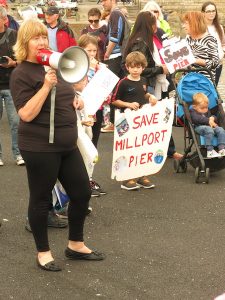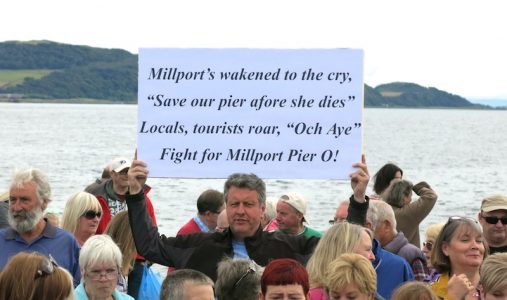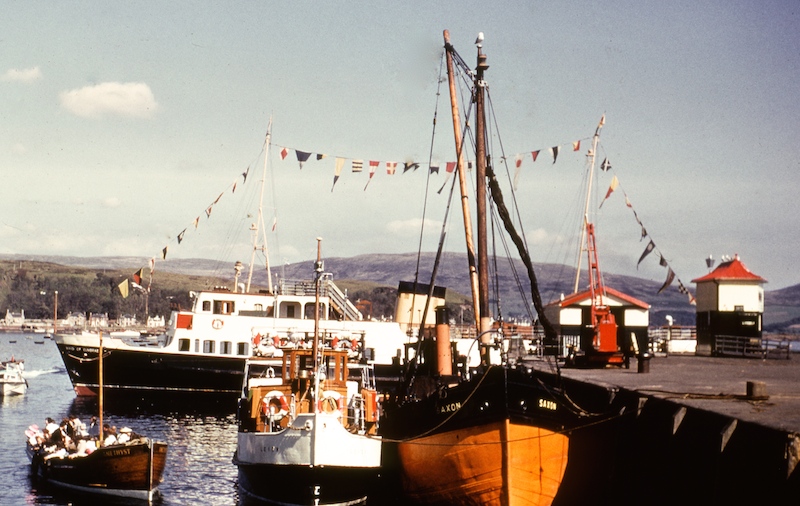
Sending a message to North Ayrshire Council: the ‘sit in’ on Millport’s Old Pier on 26 August 2017. Copyright CRSC
Can ‘people power’ stop the apparently relentless succession of pier closures around Britain’s shores? The latest to face demolition is Millport’s Old Pier, but the people of Cumbrae are not letting it happen without a fight. Andrew Clark offers a personal view.
On Saturday afternoon, along with about 200 others, I took part in a good-humoured ‘sit in’ on Millport’s Old Pier. It was a gathering of locals, weekenders and holidaymakers, all eager to demonstrate support for what, since 1833, has been the focal point of the town’s frontage.

Campaign supporters who live further afield were invited to take part in a ‘virtual sit in’ and send photos of their banners. Most showed Waverley. Copyright Victoria Tait
The ‘sit in’ lasted about half an hour and featured a specially scripted song, prizes for the best banner and a rousing speech. It was organised by the ‘Save Millport Pier’ campaign, which is petitioning North Ayrshire Council (NAC), owner of the pier, to retain it as a working facility, capable of serving not just yachts and fishing boats, but also passenger vessels, such as Waverley and Clyde Clipper, which were once its raison d’être. Barely three weeks after its launch, the petition has gathered more than 5,000 signatures.
This is one of those rare occasions when a community speaks with a single voice. Millport knows what it doesn’t want — that’s the easy bit. It doesn’t want the timber part of the pier to be replaced by an ugly breakwater of rock armour, as proposed by the council, which closed the pier to passenger ships three years ago after pronouncing it unsafe.
What Millport has not yet decided is what it wants in place of the present pier, and whether it can persuade NAC to back whatever proposal it comes up with. Only 25 years ago the timber pier underwent an expensive renovation, part-funded by Highlands and Islands Enterprise. But local authority officials saw no definable financial gain from the pier and allowed it to deteriorate. They now want to demolish it.
Outsiders may wonder why it has taken so long for a protest campaign to get underway. The reason is simple: Millport has been kicked into action by NAC’s £12m Millport Flood Protection Scheme. This proposes the construction of concrete walls along virtually the entire Millport prom, on the frankly unbelievable pretext that as many as 800 Millport properties are at risk of flooding. It also calls for the replacement of the pier by high, impenetrable rock armour, removing the need for maintenance but potentially changing the eco-system of shoreline, seabed, water currents and drainage.
Littered with jargon such as ‘scoping’ and ‘marine tourism growth opportunities’, the scheme was drawn up by an Edinburgh-based consultancy without attempting first to understand Cumbrae’s traditions and aspirations.
But enough voices were raised during public consultations last winter to force NAC to consider alternatives. These are now being assessed — another boon to the consultants.
The most favoured alternative involves the creation of a stone breakwater linking the outer Eilean with two small neighbouring islands in Millport Bay — effectively stopping southerly storms from damaging the prom, as happened last on 3-4 January 1991. This would remove the need for a new concrete wall along the front and allow a more creative redevelopment of the harbour area. It would also limit harbour access to a single passage (the one closest to West Bay), closing the door to Waverley.
By objecting to this and advocating restoration of the pier, people like me and Alastair Chisholm (pillar of the Millport community and fellow CRSC member) risk being accused of misty nostalgia for a world that no longer exists — a world represented by Talisman, ‘Maids’, ‘wee ferries’ and even dear old Keppel, on which I worked as a seaman during student holidays. These were the vessels that took islanders home from school, brought hundreds of thousands to Millport on family holidays, and cast a spell on countless day trippers.
Other Clyde communities have shown how a traditional pier can still benefit the community. Blairmore, Kilcreggan and Tarbert fall into that category, the latter’s pier having been repaired quite recently for Waverley’s benefit without massive expenditure. But it is Tighnabruaich that has most in common with Millport. Its ‘new road’, built in the early 1970s, is a rough equivalent to the Largs-Cumbrae Slip ferry, with the same benefits and drawbacks. It made the place more accessible but led to a downturn of community life. There the similarity ends. Tighnabruaich Pier, owned by Argyll & Bute Council, has been well maintained, thanks to the direct involvement of council liaison officers and the work of Tighnabruaich Pier Association, formed in 1999 by local residents. Five years ago the council voted to spend more than £160,000 on repairs and improvements.
Graeme Hogg, the Pier Association’s Chairman, says Tighnabruaich benefits significantly from Waverley’s presence. “Every time she visits, she deposits a few hundred people who spend money in the shops and tearooms and discover what a fantastic place it is. So there’s a chance of long-term spin-off in the form of future visits from people who see it first from the decks of Waverley.”

Every week when Waverley called at the Old Pier, Millport’s country dancers put on a show. Copyright Andrew Clark
It helps that Argyll & Bute is at heart a rural council. It recognises that a place like Tighnabruaich depends on tourists, and a pier is a way of encouraging them to come — a symbol of the community’s ‘destination status’.
North Ayrshire’s focus, by contrast, is the densely populated conurbation of Irvine and Ardrossan/Saltcoats/Stevenston. From that perspective, a timber pier on a small island must count as anachronistic and unnecessary. Because the council wants rid of it, it will always look at it from the most expensive angle and say ‘no’ — usually through the medium of consultants, who invariably opt for a heavily engineered solution, resulting in a level of cost that far exceeds a pragmatic, workable solution like Tarbert’s.
For the past 18 months the people of Millport have been dazzled by a multi-million pound scheme that vastly overestimates the risk of flood damage and the finance needed to insure against it — when what the town really needs is regular upkeep of its prom and a decent repair of its steamer pier. ‘Flood protection’ is a red herring, dangled by NAC to mask its neglect of basic maintenance across a range of island facilities.
If ‘Save Millport Pier’ is to take its campaign further, it needs to come up with a single affordable proposal, get local ward councillors to unite behind it and put together a plan for volunteer community pier operation — on similar lines to Cumbrae’s successful toilet maintenance programme.
Then, just possibly, we might foresee the day when a crowd gathers on Millport’s Old Pier not for a protest singalong, but to welcome Waverley back to the town’s heart.

In its postwar heyday Millport welcomed steamers even larger than Waverley, such as Queen Mary II (currently undergoing static preservation in Glasgow). Copyright Andrew Clark/The Estate of Walter and Effie Kerr

















